Drinking water
Drinking water, also known as potable water, is water that is safe to drink or use for food preparation. The amount of drinking water required to maintain good health varies, and depends on physical activity level, age, health-related issues, and environmental conditions.[1] On average, people in the United States generally drink one litre of water per day and 95% drink less than three litres per day.[2] For those who work in a hot climate, up to 16 litres a day may be required.[1]
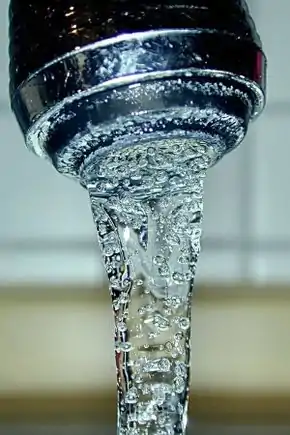
Typically in developed countries, tap water meets drinking water quality standards, even though only a small proportion is actually consumed or used in food preparation. Other typical uses include washing, toilets, and irrigation. Greywater may also be used for toilets or irrigation. Its use for irrigation however may be associated with risks.[3] Water may also be unacceptable due to levels of toxins or suspended solids.
Globally, by 2015, 89% of people had access to water from a source that is suitable for drinking – called improved water source.[3] In Sub-Saharan Africa, access to potable water ranged from 40% to 80% of the population. Nearly 4.2 billion people worldwide had access to tap water, while another 2.4 billion had access to wells or public taps.[3] The World Health Organization considers access to safe drinking-water a basic human right.
About 1 to 2 billion people lack safe drinking water,[4] a problem that causes 30,000 deaths each week.[5] More people die from unsafe water than from war, U.N. Secretary-General Ban Ki-Moon said in 2010.[6]
Definitions
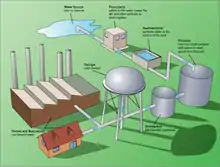

According to the World Health Organization's 2017 report, safe drinking-water is water that "does not represent any significant risk to health over a lifetime of consumption, including different sensitivities that may occur between life stages".[7]:2
A 'safely managed drinking water service" is "one located on premises, available when needed and free from contamination". By 2015, 5.2 billion people representing 71% of the global population used safely managed drinking water services.[8]
The terms 'improved water source' and 'unimproved water source' were coined in 2002 as a drinking water monitoring tool by the JMP of UNICEF and WHO. The term, improved water source refers to "piped water on premises (piped household water connection located inside the user’s dwelling, plot or yard), and other improved drinking water sources (public taps or standpipes, tube wells or boreholes, protected dug wells, protected springs, and rainwater collection)".[9] Improved sources are also monitored based on whether water is available when needed (5.8 billion people), located on premises (5.4 billion), free from contamination (5.4 billion), and "within 30 minutes round trip to collect water.'[8]:3 While improved water sources such as protected piped water are more likely to provide safe and adequate water as they may prevent contact with human excreta, for example, this is not always the case.[9] According to a 2014 study, approximately 25% of improved sources contained fecal contamination.[10]
The SDC basic drinking water service is one in which a "round trip to collect water takes 30 minutes or less". Only Australia, New Zealand, North America and Europe have almost achieved universal basic drinking water services.[8]:3
Importance of access to safe drinking water
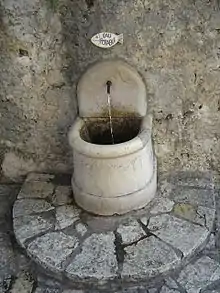
According to the World Health Organization, "access to safe drinking-water is essential to health, a basic human right and a component of effective policy for health protection."[7]:2
Requirements
The amount of drinking water required per day is variable.[1] It depends on physical activity, age, health, and environmental conditions. In the United States, the reference daily intake (RDI) for total water is 3.7 litres (130 imp fl oz; 130 US fl oz) per day for human males older than 18, and 2.7 litres (0.59 imp gal; 0.71 US gal) per day for human females older than 18 which includes drinking water, water in beverages, and water contained in food.[11] The European Food Safety Authority recommends 2.0 litres (70 imp fl oz; 68 US fl oz) per day for adult women and 2.5 litres (88 imp fl oz; 85 US fl oz) per day for adult men.[12] An individual's thirst provides a better guide for how much water they require rather than a specific, fixed quantity.[13] Americans, on average, drink one litre (35 imp fl oz; 34 US fl oz) of water a day and 95% drink less than three litres (110 imp fl oz; 100 US fl oz) per day.[2] Physical exercise and heat exposure cause loss of water and therefore may induce thirst and greater water intake.[14] Physically active individuals in hot climates may have total daily water needs of 6 litres (210 imp fl oz; 200 US fl oz) or more.[14]
The drinking water contribution to mineral nutrients intake is also unclear. Inorganic minerals generally enter surface water and ground water via storm water runoff or through the Earth's crust. Treatment processes also lead to the presence of some minerals. Examples include calcium, zinc, manganese, phosphate, fluoride and sodium compounds.[15] Water generated from the biochemical metabolism of nutrients provides a significant proportion of the daily water requirements for some arthropods and desert animals, but provides only a small fraction of a human's necessary intake. There are a variety of trace elements present in virtually all potable water, some of which play a role in metabolism. For example, sodium, potassium and chloride are common chemicals found in small quantities in most waters, and these elements play a role in body metabolism. Other elements such as fluoride, while beneficial in low concentrations, can cause dental problems and other issues when present at high levels.
Fluid balance is key. Profuse sweating can increase the need for electrolyte (salt) replacement. Water intoxication (which results in hyponatremia), the process of consuming too much water too quickly, can be fatal.[16][17] Water makes up about 60% of the body weight in men and 55% of weight in women.[18] A baby is composed of about 70% to 80% water while the elderly are composed of around 45%.[19]
Water resources
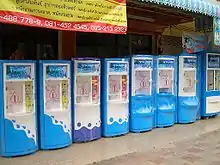
Global
Water covers approximately 70% of the Earth's surface, where approximately 97.2% of it is saline, only 2.8% fresh. Potable water is available in almost all populated areas of the Earth, although it may be expensive and the supply may not always be sustainable. Sources where water may be obtained include:
- Ground sources such as groundwater, springs, hyporheic zones and aquifers
- Precipitation which includes rain, hail, snow, fog, etc.
- Surface water such as rivers, streams, glaciers
- Biological sources such as plants
- Desalinated seawater
- Water supply network
- Atmospheric water generator
Springs are often used as sources for bottled waters.[20] Tap water, delivered by domestic water systems refers to water piped to homes and delivered to a tap or spigot. For these water sources to be consumed safely, they must receive adequate treatment and meet drinking water regulations.[21]
The most efficient and convenient way to transport and deliver potable water is through pipes. Plumbing can require significant capital investment. Some systems suffer high operating costs. The cost to replace the deteriorating water and sanitation infrastructure of industrialized countries may be as high as $200 billion a year. Leakage of untreated and treated water from pipes reduces access to water. Leakage rates of 50% are not uncommon in urban systems.[22]
Because of the high initial investments, many less wealthy nations cannot afford to develop or sustain appropriate infrastructure, and as a consequence people in these areas may spend a correspondingly higher fraction of their income on water.[23] 2003 statistics from El Salvador, for example, indicate that the poorest 20% of households spend more than 10% of their total income on water. In the United Kingdom, authorities define spending of more than 3% of one's income on water as a hardship.[24]
United States
In the US, the typical water consumption per capita, at home, is 69.3 US gallons (262 l; 57.7 imp gal) of water per day.[25][26] Of this, only 1% of the water provided by public water suppliers is for drinking and cooking.[27] Uses include (in decreasing order) toilets, washing machines, showers, baths, faucets, and leaks. Public water systems, defined as systems that serve more than 25 customers or 15 service connections, are regulated by the U.S. Environmental Protection Agency (EPA) under the Safe Drinking Water Act.[27] In some parts of the country water supplies are dangerously low due to drought and depletion of the aquifers, particularly in the West and the South East region of the U.S.[28] Many of the dry, desert areas in the U.S. have this problem. According to AZCentral, "Arizona’s groundwater levels are plummeting in many areas... The water levels in more than 2,000 wells have dropped more than 100 feet since they were first drilled."[29] That sample size is approximately a fourth of Arizona's drinking-water wells.
Canada
The drinking water in Canada's cities is regularly tested and considered safe, but on many native reserves clean drinking water is considered a luxury.[30] The Canadian government regulates water quality for off-reserve communities, not on reserves where indigenous people live, making it extremely difficult for indigenous people to have access to clean, sanitary water.[31] According to the Human Rights Watch, First Nations reserves in Canada were found to have water contaminations that included coliform, E. coli, Trihalomethane, and uranium, which may cause gastrointestinal diseases or increased risks for cancer.[31] The latest Canadian government of 2015 was to spend additional funds to fix the problem but has not had success.[32][33]
Access to potable water
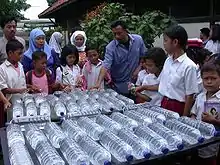
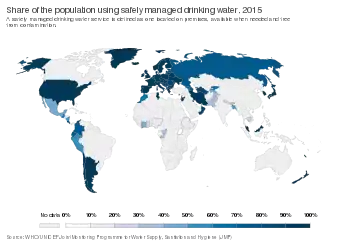
.jpg.webp)
In 1990, only 76 percent of the global population had access to drinking water. By 2015 that number had increased to 91 percent.[9] As of 2017, 90% of people having access to water from a source that is suitable for drinking – called "improved water source" – and 71% of the world could access safely managed drinking water that is clean and available on-demand.[3] In 1990, most countries in Latin America, East and South Asia, and Sub-Saharan Africa were well below 90%. In Sub-Saharan Africa, where the rates are lowest, household access ranges from 40 to 80 percent.[9] Countries that experience violent conflict can have reductions in drinking water access: One study found that a conflict with about 2,500 battle deaths deprives 1.8% of the population of potable water.[34]
.jpg.webp)
Estimates suggest that at least 25% of improved sources contain fecal contamination.[10] 1.8 billion people still use an unsafe drinking water source which may be contaminated by feces.[3] This can result in infectious diseases, such as gastroenteritis, cholera, and typhoid, among others.[3] Reduction of waterborne diseases and development of safe water resources is a major public health goal in developing countries. Bottled water is sold for public consumption in most parts of the world.
Developing countries
One of the Millennium Development Goals (MDGs) set by the UN includes environmental sustainability. In 2004, only 42% of people in rural areas had access to clean water worldwide.[36] Projects such as Democratisation of Water and Sanitation Governance by Means of Socio-Technical Innovations work to develop new accessible water treatment systems for poor rural areas, reducing the price of drinking water from US$6.5 per cubic meter to US$1.[37]
The World Health Organization/UNICEF Joint Monitoring Program (JMP) for Water Supply and Sanitation[38] is the official United Nations mechanism tasked with monitoring progress towards the Millennium Development Goal (MDG) relating to drinking-water and sanitation (MDG 7, Target 7c), which is to: "Halve, by 2015, the proportion of people without sustainable access to safe drinking-water and basic sanitation".[39]
According to this indicator on improved water sources, the MDG was met in 2010, five years ahead of schedule. Over 2 billion more people used improved drinking water sources in 2010 than did in 1990. However, the job is far from finished. 780 million people are still without improved sources of drinking water, and many more people still lack safe drinking water. Estimates suggest that at least 25% of improved sources contain fecal contamination[10] and an estimated 1.8 billion people globally use a source of drinking water that suffers from fecal contamination.[40] The quality of these sources varies over time and often gets worse during the wet season.[41] Continued efforts are needed to reduce urban-rural disparities and inequities associated with poverty; to dramatically increase safe drinking water coverage in countries in sub-Saharan Africa and Oceania; to promote global monitoring of drinking water quality; and to look beyond the MDG target towards universal coverage.[42]
Expanding WASH (Water, Sanitation, Hygiene) coverage and monitoring in non-household settings such as schools, healthcare facilities, and work places, is one of the Sustainable Development Goals.[43]
One organisation working to improve the availability of safe drinking water in some the world's poorest countries is WaterAid International. Operating in 26 countries,[44] WaterAid is working to make lasting improvements to peoples' quality of life by providing long-term sustainable access to clean water in countries such as Nepal, Tanzania, Ghana and India. It also works to educate people about sanitation and hygiene.[45]
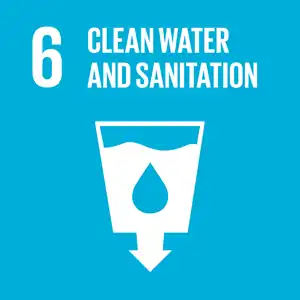
Sanitation and Water for All (SWA) is a partnership that brings together national governments, donors, UN agencies, NGOs and other development partners. They work to improve sustainable access to sanitation and water supply to meet and go beyond the MDG target.[46] In 2014, 77 countries had already met the MDG sanitation target, 29 were on track and, 79 were not on-track.[47] The sustainable development goals were established and agreed by the UN in 2015 with the intention that they should be achieved by 2030. Goal 6 deals with the provision of clean water and sanitation.
Mexico
Amidst the water crisis occurring in Mexico, Mexico City has been sinking downwards approximately 1 meter every year.[48] Due to years of draining groundwater for public and agricultural use, the negative effects of relying on groundwater has influenced the Mexican government to call attention towards a campaign titled "February 2010: The City May Run Out of Water."[49] Mexico continues to pump out groundwater from deeper ground layers, causing the drainage of soil and weak ground.[50] According to the World Health Organization in 2015, approximately 100% of urban populations used at least basic drinking water sources, whereas approximately 94% of rural populations used at least basic drinking-water.
Climate change aspects
The World Wildlife Fund predicts that in the Himalayas, retreating glaciers could reduce summer water flows by up to two-thirds. In the Ganges area, this would cause a water shortage for 500 million people.[51] Climate change impacts potable water in the Hindu Kush Himalaya (HKH) area, where around 1.4 billion people are dependent on the five main rivers of Himalaya mountains.[52] Although the impact will vary from place to place, it is predicted that the amount of meltwater will initially increase due to retreating glaciers and then gradually decrease because of reducing in glacier mass.[53] In those areas where the amount of available water decreases, climate change makes it difficult to improve access to safe drinkable water.[54] HKH area faces rapid urbanization causing a severe shortage of water and pressure on water resources. Rural areas will also suffer because of a lack of effective water management infrastructure and limited access to drinking water. More people will migrate because of the scarcity of drinking water. This situation will increase inequality by leaving the poor behind that cause higher mortality and suicide rate, and accelerate further urbanization.[55] United Nations secretary-general Ban Ki-moon has said this may lead to violent conflicts.[56]
Health aspects
Contaminated water is estimated to result in more than half a million deaths per year.[3] Contaminated water with the lack of sanitation was estimated to cause about one percent of disability adjusted life years worldwide in 2010.[57] As contaminated water takes its toll on the health of those exposed, the duration of exposure plays a part in the effects of certain diseases.
Diarrheal diseases
Over 90% of deaths from diarrheal diseases in the developing world today occur in children under five years old.[58]:11 According to the World Health Organization, the most common diseases linked with poor water quality are cholera, diarrhoea, dysentery, hepatitis A, typhoid, and polio.[59] Malnutrition, especially protein-energy malnutrition, can decrease the children's resistance to infections, including water-related diarrheal diseases. Between 2000 and 2003, 769,000 children under five years old in sub-Saharan Africa died each year from diarrheal diseases. As a result from poor water quality and bad sanitation, an estimated 829,000 people die each year from diarrhoea.[59] Only thirty-six percent of the population in the sub-Saharan region have access to proper means of sanitation. More than 2,000 children's lives are lost every day. In South Asia, 683,000 children under five years old died each year from diarrheal disease from 2000 to 2003. During the same period, in developed countries, 700 children under five years old died from diarrheal disease. Improved water supply reduces diarrhea morbidity by 25% and improvements in drinking water through proper storage in the home and chlorination reduces diarrhea episodes by 39%.[58]
Well contamination with arsenic and fluoride
Some efforts at increasing the availability of safe drinking water have been disastrous. When the 1980s were declared the "International Decade of Water" by the United Nations, the assumption was made that groundwater is inherently safer than water from rivers, ponds, and canals. While instances of cholera, typhoid and diarrhea were reduced, other problems emerged due to polluted groundwater.
Sixty million people are estimated to have been poisoned by well water contaminated by excessive fluoride, which dissolved from granite rocks. The effects are particularly evident in the bone deformations of children. Similar or larger problems are anticipated in other countries including China, Uzbekistan, and Ethiopia. Although helpful for dental health in low dosage, fluoride in large amounts interferes with bone formation.[60]
Half of Bangladesh's 12 million tube wells contain unacceptable levels of arsenic due to the wells not dug deep enough (past 100 meters). The Bangladeshi government had spent less than US$7 million of the 34 million allocated for solving the problem by the World Bank in 1998.[60][61] Natural arsenic poisoning is a global threat with 140 million people affected in 70 countries globally.[62] These examples illustrate the need to examine each location on a case-by-case basis and not assume what works in one area will work in another.
Identifying hazardous substances
In 2008, the Swiss Federal Institute of Aquatic Science and Technology, Eawag, developed a method by which hazard maps could be produced for geogenic toxic substances in groundwater.[63][64][65][66] This provides an efficient way of determining which wells should be tested.
Water quality
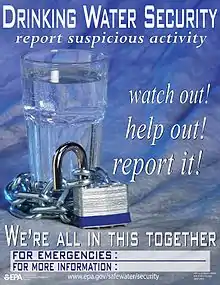
Parameters for drinking water quality typically fall within three categories:
- physical
- chemical
- microbiological
Physical and chemical parameters include heavy metals, trace organic compounds, total suspended solids (TSS), and turbidity.
Microbiological parameters include Coliform bacteria, E. coli, and specific pathogenic species of bacteria (such as cholera-causing Vibrio cholerae), viruses, and protozoan parasites.
Chemical parameters tend to pose more of a chronic health risk through buildup of heavy metals although some components like nitrates/nitrites and arsenic can have a more immediate impact. Physical parameters affect the aesthetics and taste of the drinking water and may complicate the removal of microbial pathogens.
Originally, fecal contamination was determined with the presence of coliform bacteria, a convenient marker for a class of harmful fecal pathogens. The presence of fecal coliforms (like E. Coli) serves as an indication of contamination by sewage. Additional contaminants include protozoan oocysts such as Cryptosporidium sp., Giardia lamblia, Legionella, and viruses (enteric).[67] Microbial pathogenic parameters are typically of greatest concern because of their immediate health risk.
Throughout most of the world, the most common contamination of raw water sources is from human sewage in particular human faecal pathogens and parasites. In 2006, waterborne diseases were estimated to cause 1.8 million deaths while about 1.1 billion people lacked proper drinking water.[68] In parts of the world, the only sources of water are from small streams that are often directly contaminated by sewage.
There is increasing concern over the health effects of engineered nanoparticles (ENPs) released into the natural environment. One potential indirect exposure route is through the consumption of contaminated drinking waters. To address these concerns, the U.K. Drinking Water Inspectorate (DWI) has published a "Review of the risks posed to drinking water by man-made nanoparticles" (DWI 70/2/246). The study, which was funded by the Department for Food and Rural Affairs (Defra), was undertaken by the Food and Environment Research Agency (Fera) in collaboration with a multi-disciplinary team of experts including scientists from the Institute of Occupational Medicine/SAFENANO. The study explored the potential for ENPs to contaminate drinking water supplies and to establish the significance of the drinking water exposure route compared to other routes of exposure.
Test have found 83% of 159 water samples from around the world were contaminated with plastic fibers.[69][70]
Greenpeace reported that in 2005 more than half the surface rivers in eight provinces of China were unsuitable for human contact.[71]
Improved water sources
Access to safe drinking water is indicated by safe water sources. These improved drinking water sources include household connection, public standpipe, borehole condition, protected dug well, protected spring, and rain water collection. Sources that do not encourage improved drinking water to the same extent as previously mentioned include: unprotected wells, unprotected springs, rivers or ponds, vender-provided water, bottled water (consequential of limitations in quantity, not quality of water), and tanker truck water. Access to sanitary water comes hand in hand with access to improved sanitation facilities for excreta, such as connection to public sewer, connection to septic system, or a pit latrine with a slab or water seal.[72]
Water treatment
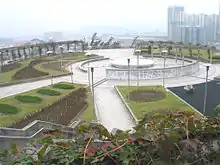
Most water requires some treatment before use; even water from deep wells or springs. The extent of treatment depends on the source of the water. Appropriate technology options in water treatment include both community-scale and household-scale point-of-use (POU) designs.[73] Only a few large urban areas such as Christchurch, New Zealand have access to sufficiently pure water of sufficient volume that no treatment of the raw water is required.[74]
In emergency situations when conventional treatment systems have been compromised, waterborne pathogens may be killed or inactivated by boiling[75] but this requires abundant sources of fuel, and can be very onerous on consumers, especially where it is difficult to store boiled water in sterile conditions. Other techniques, such as filtration, chemical disinfection, and exposure to ultraviolet radiation (including solar UV) have been demonstrated in an array of randomized control trials to significantly reduce levels of water-borne disease among users in low-income countries,[76] but these suffer from the same problems as boiling methods.
Another type of water treatment is called desalination and is used mainly in dry areas with access to large bodies of saltwater.
Point of use methods
The ability of point of use (POU) options to reduce disease is a function of both their ability to remove microbial pathogens if properly applied and such social factors as ease of use and cultural appropriateness. Technologies may generate more (or less) health benefit than their lab-based microbial removal performance would suggest.
The current priority of the proponents of POU treatment is to reach large numbers of low-income households on a sustainable basis. Few POU measures have reached significant scale thus far, but efforts to promote and commercially distribute these products to the world's poor have only been under way for a few years.
Solar water disinfection is a low-cost method of purifying water that can often be implemented with locally available materials.[77][78][79][80] Unlike methods that rely on firewood, it has low impact on the environment.
Regulations
Guidelines for the assessment and improvement of service activities relating to drinking water have been published in the form of International standards for drinking water such as ISO 24510.[81]
European Union
The EU sets legislation on water quality. Directive 2000/60/EC of the European Parliament and of the Council of 23 October 2000 establishing a framework for Community action in the field of water policy, known as the water framework directive, is the primary piece of legislation governing water.[82] This drinking water directive relates specifically to water intended for human consumption.
Each member state is responsible for establishing the required policing measures to ensure that the legislation is implemented. For example, in the UK the Water Quality Regulations prescribe maximum values for substances that affect wholesomeness and the Drinking Water Inspectorate polices the water companies.
United States
In the United States, the Environmental Protection Agency (EPA) sets standards for public water systems under the Safe Drinking Water Act (SDWA).[83] As of 2019 EPA has issued 88 standards for microorganisms, chemicals and radionuclides.[84] The Food and Drug Administration (FDA) regulates bottled water as a food product under the Federal Food, Drug, and Cosmetic Act (FFDCA).[85] Bottled water is not necessarily more pure, or more tested, than public tap water.[86] Peter W. Preuss, former head of EPA's division analyzing environmental risks, has been "particularly concerned" about current drinking water standards, and suggested in 2009 that regulations against certain chemicals should be tightened.[87]
In 2010 the EPA showed that 54 active pharmaceutical ingredients and ten metabolites had been found in treated drinking water. An earlier study from 2005 by the EPA and the Geographical Survey states that 40% of water was contaminated with nonprescription pharmaceuticals, and it has been reported that 8 of the 12 most commonly occurring chemicals in drinking water are estrogenic hormones.[88] Of the pharmaceutical components found in drinking water, the EPA only regulates lindane.[84] In 2009, the EPA did announce another 13 chemicals, hormones, and antibiotics that could potentially be regulated.[89][90]
EPA published a proposed rule on June 26, 2019 that would establish a standard for perchlorate. The Agency is proposing a maximum contaminant level of 0.056 mg/L.[91]
Russian Federation
A list of normative documents that regulate the quality of drinking water in Russia:
- Sanitary norms and rules SanPin 2.1.4.1074-01 "Drinking Water. Hygienic requirements for water quality of centralized drinking water supply. Quality Control. "[92]
- Sanitary norms and rules SanPin 2.1.4.1116-02 "Drinking Water. Hygienic requirements for water quality, packaged in a container. Quality Control. "[93]
Other animals
.jpeg.webp)
The qualitative and quantitative aspects of drinking water requirements on domesticated animals are studied and described within the context of animal husbandry. However, relatively few studies have been focused on the drinking behavior of wild animals. A recent study has shown that feral pigeons do not discriminate drinking water according to its content of metabolic wastes, such as uric acid or urea (mimicking feces-pollution by birds or urine-pollution by mammals respectively).[94]
See also
References
- Ann C. Grandjean (August 2004). "3" (PDF). Water Requirements, Impinging Factors, & Recommended Intakes. World Health Organization. pp. 25–34. Archived (PDF) from the original on 2016-02-22. This 2004 article focuses on the USA context and uses data collected from the US military.
- Exposure Factors Handbook: 2011 Edition (PDF). National Center for Environmental Assessment. September 2011. Archived from the original (PDF) on 24 September 2015. Retrieved 24 May 2015.
- "Water Fact sheet N°391". July 2014. Archived from the original on 5 June 2015. Retrieved 24 May 2015.
- "Drinking-water". World Health Organization. March 2018. Retrieved 23 March 2018.
- Albertiri, Heidi. "Day by day they keep chipping away..." (May 2018). The Life Style Edit (TLSE). p. 7. Retrieved 10 May 2018.
- "Unsafe water kills more people than war, Ban says on World Day". UN News. 22 March 2010. Retrieved 10 May 2018.
- Guidelines for Drinking‑water Quality (PDF) (Report) (4 ed.). World Health Organization. 2017. p. 631. ISBN 978-92-4-154995-0.
- Progress on Drinking Water, Sanitation and Hygiene (PDF) (Report). JMP, WHO and UNICEF. 2017. p. 116. ISBN 978-92-4-151289-3. Retrieved March 22, 2018.
The "Joint Monitoring Programme for Water Supply, Sanitation and Hygiene (JMP) was established in 1990. [JMP publishes] "regular global updates throughout the Millennium Development Goal period. This report is the first update of the SDG period." "Eight out of ten people (5.8 billion) used improved sources with water available when needed. 5. Three out of four people (5.4 billion) used improved sources located on premises. 6. Three out of four people (5.4 billion) used improved sources free from contamination. 7. 89 per cent of the global population (6.5 billion people) used at least a basic service; that is, an improved source within 30 minutes’ round trip to collect water. 8. 844 million people still lacked even a basic drinking water service. 9. 263 million people spent over 30 minutes per round trip to collect water from an improved source (constituting a limited drinking water service). 10. 159 million people still collected drinking water directly from surface water sources, 58% lived in sub-Saharan Africa."
- Ritchie, Hannah; Roser, Max (2018), "Water Access, Resources & Sanitation", OurWorldInData.org, retrieved March 22, 2018
- Bain, R.; Cronk, R.; Wright, J.; Yang, H.; Slaymaker, T.; Bartram, J. (2014). "Fecal Contamination of Drinking-Water in Low- and Middle-Income Countries: A Systematic Review and Meta-Analysis". PLOS Medicine. 11 (5): e1001644. doi:10.1371/journal.pmed.1001644. PMC 4011876. PMID 24800926.
- "US daily reference intake values". Iom.edu. Archived from the original on 2011-10-06. Retrieved 2011-12-05.
- EFSA Panel on Dietetic Products, Nutrition, and Allergies (2010). "Scientific Opinion on Dietary Reference Values for water". EFSA Journal. 8 (3): 1459. doi:10.2903/j.efsa.2010.1459.CS1 maint: multiple names: authors list (link)
- H. Valtin, Drink at least eight glasses of water a day." Really? Is there scientific evidence for "8 × 8"? Archived 2010-04-20 at the Wayback Machine Am J Physiol Regul Integr Comp Physiol 283: R993-R1004, 2002.
- "Report Sets Dietary Intake Levels for Water, Salt, and Potassium To Maintain Health and Reduce Chronic Disease Risk". US Institute of Medicine, Food and Nutrition Board. 11 February 2004. Retrieved 13 September 2017.
- World Health Organization Archived 2011-01-19 at the Wayback Machine (WHO). Geneva, Switzerland. Joyce Morrissey Donohue, Charles O. Abernathy, Peter Lassovszky, George Hallberg. "The contribution of drinking-water to total dietary intakes of selected trace mineral nutrients in the United States." Draft, August 2004.
- Noakes TD, Goodwin N, Rayner BL, et al. (1985). "Water intoxication: a possible complication during endurance exercise". Med Sci Sports Exerc. 17 (3): 370–75. doi:10.1249/00005768-198506000-00012. PMID 4021781.
- Noakes TD, Goodwin N, Rayner BL, Branken T, Taylor RK (2005). "Water intoxication: a possible complication during endurance exercise, 1985". Wilderness Environ Med. 16 (4): 221–27. doi:10.1580/1080-6032(2005)16[221:WIAPCD]2.0.CO;2. PMID 16366205.
- Miller, Thomas A. (2006). Modern surgical care physiologic foundations and clinical applications (3rd ed.). New York: Informa Healthcare. p. 34. ISBN 978-1-4200-1658-1. Archived from the original on 2017-09-01.
- Nancy caroline's emergency care in the streets (07 ed.). [S.l.]: Jones And Bartlett Learning. 2012. p. 340. ISBN 978-1-4496-4586-1. Archived from the original on 2017-09-01.
- Schardt, David (2000). "Water, Water Everywhere". Washington, D.C.: Center for Science in the Public Interest. Archived from the original on May 16, 2009.
- Hall, Ellen L.; Dietrich, Andrea M. (2000). "A Brief History of Drinking Water." Archived 2015-02-08 at the Wayback Machine Washington: American Water Works Association. Product No. OPF-0051634, Accessed 2012-06-13.
- United Nations. World Water Assessment Programme (2009). "Water in a Changing World: Facts and Figures." Archived 2012-06-24 at the Wayback Machine World Water Development Report 3. p. 58 Accessed 2012-06-13.
- "The water vendors of Nigeria". 2009-02-05. Archived from the original on 2009-10-22. Retrieved 2009-10-23. BBC News The water vendors of Nigeria Referenced 2008-10-20
- "| Human Development Reports" (PDF). Retrieved 2009-10-23. page 51 Referenced 2008-10-20
- Mayer, P.W.; DeOreo, W.B.; Opitz, E.M.; Kiefer, J.C.; Davis, W.Y.; Dziegielewski, B.; & Nelson, J.O., 1999. Residential End Uses of Water. AWWARF and AWWA, Denver.
- William B. DeOreo, Peter Mayer, Benedykt Dziegielewski, Jack Kiefer. 2016. Residential End Uses of Water, Version 2. Water Research Foundation. Denver, Colorado.
- Joseph Cotruvo, Victor Kimm, Arden Calvert. “Drinking Water: A Half Century of Progress.” EPA Alumni Association. March 1, 2016.
- "Cashing in on climate change". IBISWorld. 29 May 2008. Archived from the original on 4 October 2008.
- James, Ian; O'Dell, Rob. "Arizona's Next Water Crisis". azcentral.com. The Republic.
- "Clean running water still a luxury on many native reserves" CBC News. April 2014
- "Canada's Obligation to End the First Nations Water Crisis". Human Rights Watch. June 7, 2016.
- "Justin Trudeau vows to end First Nations reserve boil-water advisories within 5 years" CBC News. October 2015.
- "Unsafe to drink: Water treatments fail on Canadian reserves, Globe review finds" The Globe and Mail. February 20, 2017
- Davenport, Christian; Mokleiv Nygård, Håvard; Fjelde, Hanne; Armstrong, David (2019). "The Consequences of Contention: Understanding the Aftereffects of Political Conflict and Violence". Annual Review of Political Science. 22: 361–377. doi:10.1146/annurev-polisci-050317-064057.
- "Projects". Rotary.
- Africa and the Millennium Development Goals [https://web.archive.org/web/20070611183431/www.un.org/millenniumgoals/docs/MDGafrica07.pdf]
- "Access to clean water. [Social Impact]. DESAFIO. Democratization of Water and Sanitation Governance by Means of Socio-Technical Innovation (2013-2015). Framework Programme 7 (FP7)". SIOR, Social Impact Open Repository. Archived from the original on 2017-09-05.
- "About the JMP". JMP. WHO and UNICEF. Retrieved 16 October 2019.
- United Nations:World Water Assessment Program Archived 2008-01-21 at the Wayback Machine, accessed on February 27, 2010
- Bain, R.; Cronk, R.; Hossain, R.; Bonjour, S.; Onda, K.; Wright, J.; Yang, H.; Slaymaker, T.; Hunter, P.; Prüss-Ustün, A.; Bartram, J. (2014). "Global assessment of exposure to faecal contamination through drinking water based on a systematic review". Tropical Medicine & International Health. 19 (8): 917–27. doi:10.1111/tmi.12334. PMC 4255778. PMID 24811893.
- Kostyla, C.; Bain, R.; Cronk, R.; Bartram, J. (2015). "Seasonal variation of fecal contamination in drinking water sources in developing countries: A systematic review". Science of the Total Environment. 514: 333–43. Bibcode:2015ScTEn.514..333K. doi:10.1016/j.scitotenv.2015.01.018. PMID 25676921.
- "Progress on Drinking-water and Sanitation: 2012 Update" (PDF). Archived from the original (PDF) on March 28, 2012.
- Cronk, R.; Slaymaker, T.; Bartram, J. (2015). "Monitoring drinking water, sanitation, and hygiene in non-household settings: Priorities for policy and practice". International Journal of Hygiene and Environmental Health. 218 (8): 694–703. doi:10.1016/j.ijheh.2015.03.003. PMID 25836758.
- "Where we work". WaterAid. 2011-10-26. Archived from the original on 2011-11-21. Retrieved 2011-12-05.
- "water and sanitation for all". WaterAid – International site. 2011-11-30. Archived from the original on 2011-11-13. Retrieved 2011-12-05.
- United Nations Children's Fund. UNICEF's engagement in Sanitation and Water for All (2012-07). "UNICEF's engagement in Sanitation and Water for All" Archived 2015-01-03 at the Wayback Machine.
- WHO/UNICEF Joint Monitoring Programme for Water Supply and Sanitation (JMP). A Snapshot of Progress – 2014 Update. "A Snapshot of Progress – 2014 Update." Archived 2015-01-03 at the Wayback Machine.
- "Mexico City: A City That Is Flooding, But Is Still Running Out Of Water | Water Center". watercenter.sas.upenn.edu. Retrieved 2020-11-28.
- Krebs, Michael (September 27, 2009). "Water shortage in Mexico City could echo the global water issue". Digital Journal.
- Loehnberg, Alfred. Aspects of the Sinking of Mexico City and Proposed Countermeasure. Wiley. pp. 432–440.
- "Water crisis looms as Himalayan glaciers retreat". wwf.panda.org. Retrieved 2020-11-07.
- Immerzeel, Walter W.; Beek, Ludovicus P. H. van; Bierkens, Marc F. P. (2010-06-11). "Climate Change Will Affect the Asian Water Towers". Science. 328 (5984): 1382–1385. doi:10.1126/science.1183188. ISSN 0036-8075. PMID 20538947.
- Miller, James D.; Immerzeel, Walter W.; Rees, Gwyn (November 2012). "Climate Change Impacts on Glacier Hydrology and River Discharge in the Hindu Kush–Himalayas". Mountain Research and Development. 32 (4): 461–467. doi:10.1659/MRD-JOURNAL-D-12-00027.1. ISSN 0276-4741.
- Reinman, Suzanne L. (2012-02-10). "Intergovernmental Panel on Climate Change (IPCC)201280Intergovernmental Panel on Climate Change (IPCC). Geneva: World Meteorological Organization and United Nations Environment Programme Last visited October 2011. Gratis URL: www.ipcc.ch/". Reference Reviews. 26 (2): 41–42. doi:10.1108/09504121211205250. ISSN 0950-4125.
- Wester, Philippus; Mishra, Arabinda; Mukherji, Aditi; Shrestha, Arun Bhakta, eds. (2019). "The Hindu Kush Himalaya Assessment". doi:10.1007/978-3-319-92288-1. hdl:10023/17268. Cite journal requires
|journal=(help) - Richard Wachman (8 December 2007). "Water becomes the new oil as world runs dry". The Guardian. Archived from the original on 25 September 2015.
- Engell, Rebecca E; Lim, Stephen S (June 2013). "Does clean water matter? An updated meta-analysis of water supply and sanitation interventions and diarrhoeal diseases". The Lancet. 381: S44. doi:10.1016/S0140-6736(13)61298-2. S2CID 54340036.
- Water for life: making it happen (PDF). WHO/UNICEF. 2005. ISBN 978-92-4-156293-5. Archived (PDF) from the original on 2013-12-10.
- "Drinking water".
- Pearce, Fred (2006). When the Rivers Run Dry: Journeys Into the Heart of the World's Water Crisis. Toronto: Key Porter. ISBN 978-1-55263-741-8.
- Bagla, Pallava (2003-06-05). "Arsenic-Laced Well Water Poisoning Bangladeshis". National Geographic News. Washington: National Geographic Society. Archived from the original on 2009-10-02.
- Bagchi, Sanjit (2007-11-20). "Arsenic threat reaching global dimensions" (PDF). Canadian Medical Association Journal. 177 (11): 1344–45. doi:10.1503/cmaj.071456. ISSN 1488-2329. PMC 2072985. PMID 18025421.
- Amini, Manouchehr; Mueller, Kim; Abbaspour, Karim C.; Rosenberg, Thomas; Afyuni, Majid; Møller, Klaus N.; Sarr, Mamadou; Johnson, C. Annette (2008-05-15). "Statistical Modeling of Global Geogenic Fluoride Contamination in Groundwaters". Environmental Science & Technology. 42 (10): 3662–3668. Bibcode:2008EnST...42.3662A. doi:10.1021/es071958y. ISSN 0013-936X. PMID 18546705.
- Amini, Manouchehr; Abbaspour, Karim C.; Berg, Michael; Winkel, Lenny; Hug, Stephan J.; Hoehn, Eduard; Yang, Hong; Johnson, C. Annette (2008-05-15). "Statistical Modeling of Global Geogenic Arsenic Contamination in Groundwater". Environmental Science & Technology. 42 (10): 3669–75. Bibcode:2008EnST...42.3669A. doi:10.1021/es702859e. ISSN 0013-936X. PMID 18546706.
- Winkel, Lenny; Berg, Michael; Amini, Manouchehr; Hug, Stephan J.; Johnson, C. Annette (2008). "Predicting groundwater arsenic contamination in Southeast Asia from surface parameters". Nature Geoscience. 1 (8): 536–42. Bibcode:2008NatGe...1..536W. doi:10.1038/ngeo254.
- Ibrahim, Jewel (2015-10-20). "Water purification by Water ionization". Soft Water Lab. Archived from the original on 2017-04-27. Retrieved 2017-04-29.
- EPA. Washington, D.C. "Drinking Water Contaminants: Microorganisms." Archived 2015-02-02 at the Wayback Machine 2010-09-21.
- U.S. Centers for Disease Control and Prevention. Atlanta, Georgia. "Safe Water System: A Low-Cost Technology for Safe Drinking Water." Archived 2008-10-10 at the Wayback Machine Fact Sheet, World Water Forum 4 Update. March 2006.
- editor, Damian Carrington Environment (2017-09-05). "Plastic fibres found in tap water around the world, study reveals". The Guardian. ISSN 0261-3077. Retrieved 2017-09-08.CS1 maint: extra text: authors list (link)
- "Invisibles". orbmedia.org. Retrieved 2017-09-08.
- "Nearly half of China's provinces have failed to clean up their water". Greenpeace. 1 June 2017. Retrieved 21 November 2020.
- Meeting the MDG Drinking Water and Sanitation Target: A Mid-Term Assessment of Progress Archived 2016-03-04 at the Wayback Machine
- Centre for Affordable Water and Sanitation Technology. Calgary, Alberta. "Household Water Treatment Guide," March 2008. Archived September 20, 2008, at the Wayback Machine
- "Our water – Water supply". Christchurch City Council. Christchurch, NZ. Archived from the original on 12 May 2015.
- World Health Organization, Geneva (2004). "Guidelines for Drinking-water Quality. Volume 1: Recommendations." Archived 2016-03-04 at the Wayback Machine 3rd ed.
- Clasen, T.; Schmidt, W.; Rabie, T.; Roberts, I.; Cairncross, S. (2007-03-12). "Interventions to improve water quality for preventing diarrhoea: systematic review and meta-analysis". British Medical Journal. 334 (7597): 782. doi:10.1136/bmj.39118.489931.BE. PMC 1851994. PMID 17353208.
- Conroy, RM.; Meegan, ME.; Joyce, T.; McGuigan, K.; Barnes, J. (October 1999). "Solar disinfection of water reduces diarrhoeal disease: an update". Arch Dis Child. 81 (4): 337–38. doi:10.1136/adc.81.4.337. PMC 1718112. PMID 10490440.
- Conroy, R.M.; Meegan, M.E.; Joyce, T.M.; McGuigan, K.G.; Barnes, J. (2001). "Solar disinfection of drinking water protects against cholera in children under 6 years of age". Arch Dis Child. 85 (4): 293–95. doi:10.1136/adc.85.4.293. PMC 1718943. PMID 11567937.
- Rose, A; Roy, S; Abraham, V; Holmgren, G; George, K; Balraj, V; Abraham, S; Muliyil, J; et al. (2006). "Solar disinfection of water for diarrhoeal prevention in southern India". Arch Dis Child. 91 (2): 139–41. doi:10.1136/adc.2005.077867. PMC 2082686. PMID 16403847.
- Hobbins M. (2003). The SODIS Health Impact Study, Ph.D. Thesis, Swiss Tropical Institute Basel
- ISO 24510 Activities relating to drinking water and wastewater services. Guidelines for the assessment and for the improvement of the service to users
- Maria, Kaika (April 2003). "The Water Framework Directive: A New Directive for a Changing Social, Political and Economic European Framework". European Planning Studies. 11 (3): 299–316. doi:10.1080/09654310303640. S2CID 153351550.
- United States. Safe Drinking Water Act. Pub.L. 93–523; 42 U.S.C. § 300f et seq. December 16, 1974.
- "National Primary Drinking Water Regulations". Ground Water and Drinking Water. EPA. 2019-09-17.
- United States. Federal Food, Drug, and Cosmetic Act. June 25, 1938, ch. 675, 52 Stat. 1040; 21 U.S.C. § 301 et seq.
- "Bottled Water Basics". Water Health Series. EPA. September 2005. EPA 816-K-05-003. Archived from the original on 2017-04-27.
- Duhigg, Charles (2009-12-16). "That Tap Water Is Legal but May Be Unhealthy". The New York Times. p. A1. Archived from the original on 2017-04-27.
- Biological Water Filters says (2011-10-05). "Pharmaceuticals in the Water Supply: Is this a threat? – Water Matters – State of the Planet". Blogs.ei.columbia.edu. Archived from the original on 2012-01-04. Retrieved 2011-12-05.
- EPA (2009-10-08). "Drinking Water Contaminant Candidate List 3-Final." 74 FR 51850
- "Overview of CCL 3 Process". CCL and Regulatory Determination. EPA. 2017-05-22.
- EPA (2019-06-26). "National Primary Drinking Water Regulations: Perchlorate." Proposed Rule. Federal Register. 84 FR 30524.
- SanPin 2.1.4.1074-01 "Drinking Water. Hygienic requirements for water quality of centralized drinking water supply. Quality Control." Archived 2015-04-02 at the Wayback Machine
- SanPin SanPin 2.1.4.1116-02 "Drinking Water. Hygienic requirements for water quality, packaged in a container. Quality Control. " Archived 2015-04-02 at the Wayback Machine
- Olah G, Rózsa L (2006). "Nitrogen metabolic wastes do not influence drinking water preference in feral pigeons" (PDF). Acta Zoologica Academiae Scientiarum Hungaricae. 52 (4): 401–06. Archived (PDF) from the original on 2011-10-04.
External links
| Wikibooks has a book on the topic of: Drinking water |
| Wikimedia Commons has media related to Drinking water. |
| Wikivoyage has a travel guide for Water. |
| Look up drinking water or potable in Wiktionary, the free dictionary. |
- U.S. Centers for Disease Control and Prevention (CDC) Healthy Water – Drinking Water One-stop resource for drinking water
- US Environmental Protection Agency – National drinking water program – General info, regulations & technical publications
- WHO – Water Sanitation and Health: drinking water quality
- International Water Association
- UNICEF State of the World's Children 2009 Full Report with Statistics